
Atlantic City is a census-designated place (CDP) in Fremont County, Wyoming, United States. The population was 37 at the 2010 census. The community is a small mining settlement in a gulch near South Pass in southwestern Wyoming. It was founded as a mining camp following the 1867 gold rush in the region. The town declined following the end of the placer gold rush in the early 1870s, but continued to exist as advances in mining technology allowed further extraction of gold. From the 1960s until 1983, it was the location of US Steel iron ore mine. The town is accessible by gravel roads from nearby Wyoming Highway 28.
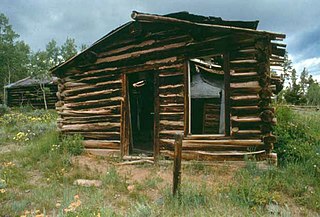
Hamilton City, or Miner's Delight as it was commonly known, was a town in Fremont County, Wyoming, United States, on the southeastern tip of the Wind River Range, that prospered during the mining boom in the American West in the second half of the 19th century. It was a "sister city" of Atlantic City and South Pass City. Today a few buildings still stand as a reminder of an era in Wyoming's past history.
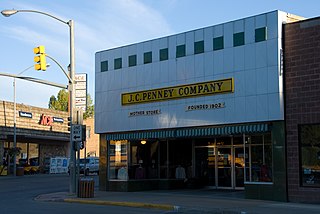
The J. C. Penney Historic District is a historic district in Kemmerer, Wyoming encompassing several properties associated with James Cash Penney (1875-1971). The district includes the Golden Rule Store, the first in what became the J. C. Penney department store chain, and Penney's home during the store's early years. The district was declared a National Historic Landmark District in 1978, for Penney's role in creating one of the first national department store chains.
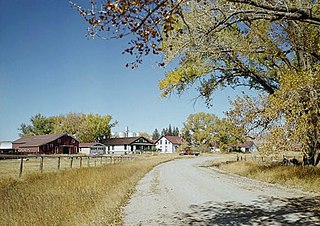
The Swan Land and Cattle Company Headquarters are a historic ranch headquarters complex on Wyoming Highway 313 in Chugwater, Wyoming. Organized in 1883 in Scotland, the Swan Company was one of the largest ranching operations in the nation in the late 19th and early 20th centuries, managing more than one million acres of land. Now a much smaller operation, its former headquarters complex was declared a National Historic Landmark in 1964.

Ten Sleep Mercantile, also known as Ten Sleep Hardware, is an example of a typical small-town general store. Located in Ten Sleep, Wyoming, it has been the focal point of the town since it was built in 1905 by H.T. Church. Upon Church's death in 1918 the property was bought by Buffalo businessman and rancher Alex Healy (Rancher) in an agreement that brought the store under the control of Paul Frison. Frison, who later served as mayor of Ten Sleep and as a Wyoming state legislator, operated the store from 1918 to 1943.

The Snake River Land Company Residence and Office are structures associated with John D. Rockefeller, Jr.'s acquisition of land in Jackson Hole, Wyoming, United States. Under the guise of the Snake River Land Company, Rockefeller bought much of the land that he eventually donated to the National Park Service, first as Jackson Hole National Monument and a year later as Grand Teton National Park. The buildings are located in the park, in the community of Moran. They served as the residence and office for SRLC vice president Harold Fabian and foreman J. Allan from 1930 to 1945. The buildings are still used by the National Park Service. The property was owned from 1926 to 1930 by John Hogan, a retired politician from the eastern United States. The Snake River Land Company bought the property in 1930.

Welty's General Store is a store in Dubois, Wyoming.
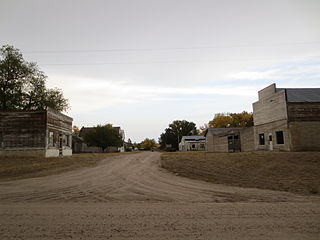
The Jay Em Historic District comprises the abandoned center of the village of Jay Em, Wyoming. The town was planned and established by Lake Harris between 1912 and 1915 as a service town supporting ranchers in the surrounding area. The place was recognized as a town in 1915 when a post office was established. Tours of the site are available by appointment.

The Hugus Hardware store, now known as Shively Hardware, is a significant commercial presence in downtown Saratoga, Wyoming. The establishment consists of two buildings. The original one-story portion was built in 1888, while the two-story section was built in 1889. Both are wood frame structures.

The South Superior Union Hall was built in 1921 in the southern part of what is now Superior, Wyoming. The hall was built by six locals of the United Mine Workers to accommodate union and community activities in the coal-mining community of Superior. Built in 1921, the two-story brick hall's plan is a parallelogram, though to be unique for its time in Wyoming. The hall housed doctors' and dentists' offices, a bowling alley and a grocery store. Dances were held in the upstairs meeting space.. With the closing of the Superior mines in the 1960s the union hall was sold in 1964. The hall was converted to a cafe, but the business did not prosper and the hall was abandoned.

Wyoming Mercantile, also known as the Aladdin General Store is a preserved small-town general store in Aladdin, Wyoming. The store, which remains in operation, was built in 1896 by Amos Robinson as Wyoming Mercantile. Robinson died the same year, and the store went to Mahlon S. Kemmerer, who placed his properties, including the Wyoming and Missouri Valley Railroad, under the Wyoming Mercantile umbrella. Railroading continued until 1927. The store has continued, serving as a post office, bar, freight station and gas station.

Itmann Company Store and Office is a historic commercial building located at Itmann, Wyoming County, West Virginia. It was designed by architect Alex B. Mahood and built in 1923–1925. It is a Classical Revival style complex built of native sandstone. It consists of four sections laid out in an open courtyard plan. Sections A and C are 2 1/2-story parapeted gable front sections located on the northern and southern sides of the courtyard and Section D is a 1-story parapeted half gable roofed loggia. It was built as a company store for the local mining community.

Fayetteville Historic District is located in Fayetteville, Texas. The small town of Fayetteville is in rural south east central Texas midway between Houston and Austin. The oldest extant building in the district was constructed in 1853. The historic district represents most of the development within town boundaries as indicated by street signs, the boundaries have been drawn to exclude some areas in town occupied primarily by construction from after 1958. The area of the district is 153.5 acres (62.1 ha) and includes 345 properties considered historical and largely intact. An additional 137 properties within district boundaries are not considered for contribution to the historic status of the district. It was added to the National Register of Historic Places (NRHP) on July 10, 2008.

The Point of Rocks Stage Station is a former resting place at the meeting point of the Overland Trail and the Union Pacific Railroad in Sweetwater County, Wyoming, USA. It was built as a stop for the Overland Stage Line in the 1861 or 1862, equidistant between the earlier Black Buttes and Salt Wells stations, which were 28 miles (45 km) apart. The station served the stage line from 1862 to 1868. In 1868, the Union Pacific line reached Point of Rocks, putting the stage line out of business. The station then became a freight depot for nearby mines, with a road leading to Atlantic City and South Pass. The freight activity declined, and in 1877, the station became a residence. At one point it was allegedly inhabited by Jim McKee, a former member of the Hole in the Wall Gang. It became the property of the state of Wyoming in 1947 and is administered as Point of Rocks Stage Station State Historic Site.

The Godahl Store is a historic consumers' co-operative general store established in the unincorporated community of Godahl in 1894. It was listed on the National Register of Historic Places as the Nelson and Albin Cooperative Mercantile Association Store in 1987 for its local significance to commerce. The store was in business through 2016.
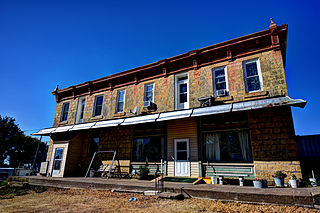
The Kegler-Gonner Store and Post Office, also known simply as Gonner's Store, is a historic commercial building located in Springbrook, Iowa, United States. Christian Kegler had the western portion of this building constructed for his general store about 1874. The post office had relocated here two years previous with Kegler as the postmaster. Three additions were built on to the original structure. The building was in its final form by 1933. John Gonner acquired a part interest in the store in 1904, and operated it outright by 1908. It was still known as Gonner's Store at least into the mid-1980s. The space is now occupied by a restaurant. The second floor houses apartments. At one time the east half of the second floor had been a boarding house.
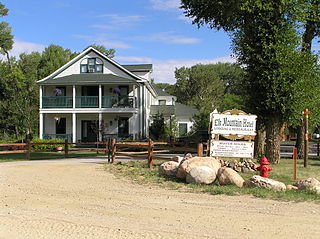
The Elk Mountain Hotel, also known as the John S. Evans Hotel, Mountain View Hotel and Grandview Hotel was built in 1905 in Elk Mountain, Wyoming on the bank of the Medicine Bow River. The two-story wood-frame building was built next to the 1880 Garden Spot Pavilion, a dance hall that was a social center in an otherwise isolated portion of Wyoming. The hotel was built by John Evans, the owner of the Elk Mountain Saloon, who in 1903 had acquired the Pavilion. Evans catered to the mining trade through the 1930s. By that time better roads allowed tourism to increase, and the hotel provided accommodation to hunters and tourists. Evans sold the property in 1947 to Mark and Lucille Jackson, who remodeled the hotel and the pavilion.

The Kahlert Mercantile Store is a historic commercial building in Browerville, Minnesota, United States. It was built in 1883 as Browerville was springing up around a newly built railroad line. The simple wooden building with a false front contained retail space on the ground floor and a community meeting hall upstairs. The building was listed on the National Register of Historic Places in 1985 for having local significance in the themes of commerce and exploration/settlement. It was nominated for being a highly intact example of the vernacular commercial architecture erected in Minnesota's railroad boomtowns.




















